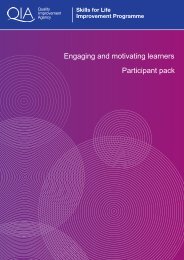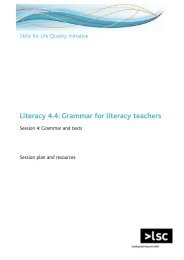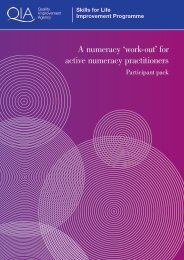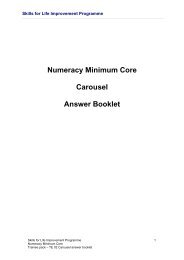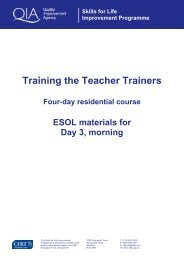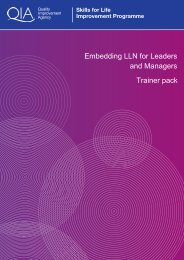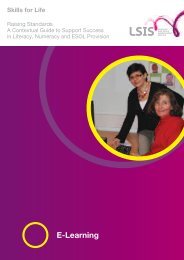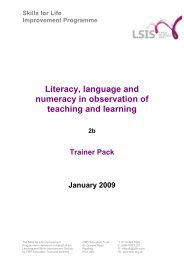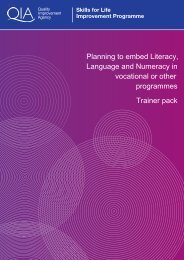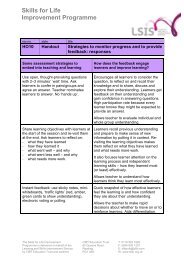Approaches to differentiated teaching and learning - Excellence ...
Approaches to differentiated teaching and learning - Excellence ...
Approaches to differentiated teaching and learning - Excellence ...
Create successful ePaper yourself
Turn your PDF publications into a flip-book with our unique Google optimized e-Paper software.
Skills for Life Quality Initiative<br />
ESOL 4.11: Current issues in <strong>teaching</strong> ESOL<br />
in post-16 education <strong>and</strong> training<br />
Session 4: <strong>Approaches</strong> <strong>to</strong> <strong>differentiated</strong> <strong>teaching</strong> <strong>and</strong> <strong>learning</strong><br />
Session plan <strong>and</strong> resources
Skills for Life Quality Initiative<br />
Session 4: <strong>Approaches</strong> <strong>to</strong> <strong>differentiated</strong> <strong>teaching</strong> <strong>and</strong><br />
<strong>learning</strong><br />
Aim<br />
For participants <strong>to</strong>:<br />
<br />
consider differentiation in <strong>teaching</strong> ESOL.<br />
Objectives<br />
By the end of the session, participants will have:<br />
<br />
<br />
explored effective strategies for differentiation in the ESOL classroom<br />
identified a range of fac<strong>to</strong>rs that affect planning for <strong>differentiated</strong> <strong>learning</strong>.<br />
Time Content Resources<br />
No. Style Title<br />
Pre-sessions tasks<br />
3.6.1<br />
Activity<br />
Follow-up task <strong>to</strong><br />
Session 3 <strong>and</strong> presession<br />
task for<br />
Session 4<br />
5<br />
(5)<br />
Introduction<br />
Briefly review the main<br />
points of Session 3.<br />
Introduce the session aim<br />
<strong>and</strong> <strong>learning</strong> objectives.<br />
4.1.1<br />
4.1.2<br />
OHT<br />
OHT<br />
Session 4: Aim<br />
Session 4: Learning<br />
objectives<br />
10<br />
Planning lessons<br />
Purpose: <strong>to</strong> share<br />
knowledge of what makes<br />
a good lesson plan.<br />
Ask participants, working<br />
in pairs or groups of three,<br />
<strong>to</strong> look at the plans they<br />
have brought in (or<br />
distribute sample plans).<br />
Participants make two lists<br />
on the grid supplied as<br />
4.2.1<br />
Activity<br />
Lesson planning<br />
Sample lesson plans<br />
(in case participants<br />
forget <strong>to</strong> bring<br />
examples)<br />
ESOL 4.11: Current issues in <strong>teaching</strong> ESOL in post-16 education <strong>and</strong> training /<br />
Session 4: <strong>Approaches</strong> <strong>to</strong> <strong>differentiated</strong> <strong>teaching</strong> <strong>and</strong> <strong>learning</strong><br />
1
Skills for Life Quality Initiative<br />
Activity sheet 4.2.1 –<br />
essential element <strong>and</strong><br />
desirable elements of a<br />
good lesson plan.<br />
(15)<br />
20<br />
Take brief feedback.<br />
Why differentiate?<br />
Purpose: <strong>to</strong> consider a<br />
wide range of learners in<br />
ESOL classes.<br />
Ask participants <strong>to</strong> work in<br />
groups. Ensure that at<br />
least one person in each<br />
group is willing <strong>and</strong> able<br />
<strong>to</strong> produce a drawing.<br />
4.3.1 Activity Why differentiate?<br />
Flipchart sheets<br />
Coloured pens<br />
Reusable adhesive<br />
Ask each group <strong>to</strong> draw on<br />
a flipchart sheet the<br />
learners in their classes (in<br />
any way they want – it<br />
can be as a drawing or<br />
diagram). Their drawing<br />
should show the need for<br />
differentiation.<br />
Each group attaches their<br />
drawing <strong>to</strong> the wall <strong>and</strong><br />
walks around <strong>to</strong> look at<br />
the other displays.<br />
Take feedback, covering<br />
points raised by particular<br />
drawings.<br />
(35)<br />
1.00<br />
List all the differences<br />
between learners that<br />
entail <strong>differentiated</strong><br />
<strong>teaching</strong> <strong>and</strong> <strong>learning</strong><br />
approaches.<br />
What is differentiation?<br />
Purpose: <strong>to</strong> draw on<br />
participants' existing<br />
experience of<br />
differentiation strategies.<br />
ESOL 4.11: Current issues in <strong>teaching</strong> ESOL in post-16 education <strong>and</strong> training /<br />
Session 4: <strong>Approaches</strong> <strong>to</strong> <strong>differentiated</strong> <strong>teaching</strong> <strong>and</strong> <strong>learning</strong><br />
2
Skills for Life Quality Initiative<br />
Activity 4.4.1 is based<br />
around watching a video<br />
sequence. Give out the<br />
activity sheet, <strong>and</strong> before<br />
showing the video, take<br />
participants’ comments on<br />
strategies they know for<br />
responding <strong>to</strong> similarities<br />
<strong>and</strong> differences among<br />
learners in an ESOL class.<br />
4.4.1<br />
Activity<br />
Differentiated<br />
<strong>teaching</strong> <strong>and</strong><br />
<strong>learning</strong> approaches<br />
Participants should list<br />
these strategies on the<br />
first part of the activity<br />
sheet.<br />
Differentiation video<br />
Purpose: video observation<br />
<strong>to</strong> see one teacher's<br />
approach <strong>to</strong><br />
differentiation.<br />
4.4.2<br />
Trainer<br />
notes<br />
Video:<br />
‘Differentiation in<br />
ESOL <strong>teaching</strong>’.<br />
London Language<br />
<strong>and</strong> Literacy Unit<br />
Video player<br />
Introduce the video. Ask<br />
participants, while<br />
watching, <strong>to</strong> note whether<br />
any approaches they<br />
identified in the first part<br />
of the activity are used in<br />
the video sequence. They<br />
should tick any strategies<br />
listed on their activity<br />
sheet that they see used<br />
in the video.<br />
Also ask participants <strong>to</strong><br />
take note of any strategies<br />
used in the video that do<br />
not appear on their list.<br />
Feedback on the video<br />
on ways of<br />
differentiating<br />
Purpose: <strong>to</strong> sum up lessons<br />
learned from the video<br />
observation <strong>and</strong><br />
participants’ own<br />
experience.<br />
ESOL 4.11: Current issues in <strong>teaching</strong> ESOL in post-16 education <strong>and</strong> training /<br />
Session 4: <strong>Approaches</strong> <strong>to</strong> <strong>differentiated</strong> <strong>teaching</strong> <strong>and</strong> <strong>learning</strong><br />
3
Skills for Life Quality Initiative<br />
Participants complete the<br />
last part of Activity 4.4.1<br />
with a partner, considering<br />
strategies they saw <strong>and</strong><br />
how effective they were<br />
for learners.<br />
Ask pairs <strong>to</strong> form groups<br />
<strong>to</strong> compare findings <strong>and</strong><br />
discuss issues raised by<br />
the video.<br />
Take feedback on<strong>to</strong> a<br />
flipchart or electronic<br />
whiteboard; list all the<br />
strategies participants saw<br />
<strong>and</strong> add any they use that<br />
were not shown.<br />
(1.35)<br />
15<br />
Refer <strong>to</strong> Trainer notes 4.4.2<br />
if necessary for a list of<br />
strategies used in the<br />
video.<br />
Fac<strong>to</strong>rs affecting<br />
planning<br />
Purpose: <strong>to</strong> demonstrate<br />
that differentiation is not<br />
just about classroom<br />
management.<br />
Refer briefly <strong>to</strong> the fac<strong>to</strong>rs<br />
affecting differentiation on<br />
Trainer notes 4.5.1.<br />
4.5.1 Trainer Fac<strong>to</strong>rs affecting<br />
notes differentiation<br />
Ask participants <strong>to</strong> work in<br />
groups <strong>and</strong> consider what<br />
the teacher needed <strong>to</strong> do<br />
in order <strong>to</strong> produce the<br />
<strong>differentiated</strong> lesson shown<br />
in the video sequence.<br />
Take brief feedback.<br />
Highlight how<br />
differentiation affects all<br />
stages of planning <strong>and</strong><br />
ESOL 4.11: Current issues in <strong>teaching</strong> ESOL in post-16 education <strong>and</strong> training /<br />
Session 4: <strong>Approaches</strong> <strong>to</strong> <strong>differentiated</strong> <strong>teaching</strong> <strong>and</strong> <strong>learning</strong><br />
4
Skills for Life Quality Initiative<br />
(1.50)<br />
<strong>teaching</strong>, drawing on<br />
Trainer notes 4.5.2 <strong>to</strong> elicit<br />
ideas <strong>and</strong> discussion.<br />
4.5.2<br />
Trainer<br />
notes<br />
Planning a<br />
<strong>differentiated</strong> lesson<br />
30<br />
Planning a <strong>differentiated</strong><br />
lesson<br />
Purpose: <strong>to</strong> provide<br />
practice in incorporating<br />
differentiation in planning.<br />
Ask participants <strong>to</strong> work in<br />
pairs or groups of three for<br />
Activity 4.6.1.<br />
4.6.1<br />
Trainer<br />
material/<br />
Activity<br />
Planning a<br />
<strong>differentiated</strong><br />
activity<br />
Ask pairs or groups <strong>to</strong><br />
select one or two units<br />
from the <strong>learning</strong><br />
materials provided. (They<br />
can choose which level<br />
they want <strong>to</strong> work on.)<br />
Selection of units<br />
from <strong>learning</strong><br />
materials<br />
Now ask each pair or<br />
group <strong>to</strong> choose one or<br />
two differentiation cards<br />
(Trainer material for<br />
Activity 4.6.1).<br />
(2.20)<br />
Participants plan<br />
differentiation in<strong>to</strong> the<br />
lesson, bearing in mind<br />
their different learners.<br />
10<br />
Review <strong>and</strong> evaluation<br />
Refer participants <strong>to</strong> the<br />
follow-up reading (Activity<br />
4.7.1). Go through Activity<br />
4.7.2: Pre-session tasks for<br />
Session 5.<br />
4.7.1<br />
4.7.2<br />
Activity<br />
Activity<br />
Follow-up readng <strong>to</strong><br />
Session 4<br />
Pre-session tasks for<br />
Session 5<br />
Revisit the session aim<br />
<strong>and</strong> <strong>learning</strong> objectives.<br />
4.7.3<br />
Activity<br />
Quiz<br />
(2.30)<br />
Ask participants <strong>to</strong><br />
complete their<br />
professional development<br />
journal (PDJ) sheet <strong>and</strong><br />
evaluation form.<br />
PDJ sheet<br />
Evaluation form<br />
ESOL 4.11: Current issues in <strong>teaching</strong> ESOL in post-16 education <strong>and</strong> training /<br />
Session 4: <strong>Approaches</strong> <strong>to</strong> <strong>differentiated</strong> <strong>teaching</strong> <strong>and</strong> <strong>learning</strong><br />
5
Skills for Life Quality Initiative<br />
Session 4: Aim<br />
For participants <strong>to</strong>:<br />
consider differentiation in <strong>teaching</strong> ESOL.<br />
ESOL 4.11: Current issues in <strong>teaching</strong> ESOL in post-16 education <strong>and</strong> training / Session 4: <strong>Approaches</strong> <strong>to</strong> <strong>differentiated</strong> <strong>teaching</strong> <strong>and</strong> <strong>learning</strong><br />
resource no.<br />
4.1.1<br />
OHT<br />
6
Skills for Life Quality Initiative<br />
Session 4: Learning objectives<br />
By the end of the session, participants will have:<br />
explored effective strategies for differentiation in<br />
the ESOL classroom<br />
identified a range of fac<strong>to</strong>rs that affect planning for<br />
<strong>differentiated</strong> <strong>learning</strong>.<br />
ESOL 4.11: Current issues in <strong>teaching</strong> ESOL in post-16 education <strong>and</strong> training / Session 4: <strong>Approaches</strong> <strong>to</strong> <strong>differentiated</strong> <strong>teaching</strong> <strong>and</strong> <strong>learning</strong><br />
resource no.<br />
4.1.2<br />
OHT<br />
7
Skills for Life Quality Initiative<br />
resource no.<br />
4.2.1<br />
Activity<br />
Lesson planning<br />
Work in pairs or groups of three. Compare the lesson plans you have<br />
brought with you.<br />
Complete the following grid by listing separately essential <strong>and</strong> desirable<br />
elements of a good lesson plan.<br />
Essential elements<br />
Desirable elements<br />
ESOL 4.11: Current issues in <strong>teaching</strong> ESOL in post-16 education <strong>and</strong> training /<br />
Session 4: <strong>Approaches</strong> <strong>to</strong> <strong>differentiated</strong> <strong>teaching</strong> <strong>and</strong> <strong>learning</strong><br />
8
Skills for Life Quality Initiative<br />
resource no.<br />
4.3.1<br />
Activity<br />
Why differentiate?<br />
Work in groups.<br />
Draw the learners in one of your classes in any way you want <strong>to</strong> – it can<br />
be as a diagram or as a drawing. Your drawing should show the need for<br />
differentiation.<br />
Attach your drawing <strong>to</strong> the wall.<br />
Look at other groups’ displayed work.<br />
ESOL 4.11: Current issues in <strong>teaching</strong> ESOL in post-16 education <strong>and</strong> training /<br />
Session 4: <strong>Approaches</strong> <strong>to</strong> <strong>differentiated</strong> <strong>teaching</strong> <strong>and</strong> <strong>learning</strong><br />
9
Skills for Life Quality Initiative<br />
resource no.<br />
4.4.1<br />
Activity<br />
Differentiated <strong>teaching</strong> <strong>and</strong> <strong>learning</strong><br />
approaches<br />
Before watching the video, list any strategies you know for responding <strong>to</strong><br />
similarities <strong>and</strong> differences among learners in an ESOL class.<br />
1.<br />
2.<br />
3.<br />
4.<br />
5.<br />
While you watch the video, tick any strategies you have listed above that<br />
you see the teacher use.<br />
After watching the video, compare notes with a partner.<br />
1. Add any other strategies you saw.<br />
2. How effective for the learners were the strategies you saw?<br />
ESOL 4.11: Current issues in <strong>teaching</strong> ESOL in post-16 education <strong>and</strong> training /<br />
Session 4: <strong>Approaches</strong> <strong>to</strong> <strong>differentiated</strong> <strong>teaching</strong> <strong>and</strong> <strong>learning</strong><br />
10
Skills for Life Quality Initiative<br />
resource no.<br />
4.4.2<br />
Trainer notes<br />
Video: ‘Differentiation in<br />
ESOL <strong>teaching</strong>’<br />
This video is taken from: Planning Learning <strong>and</strong> Recording Progress <strong>and</strong> Achievement: a<br />
Guide for Practitioners.<br />
This guide is available free from DfES publications: dfes@prolog.uk.com.<br />
Fax: 0845 6033360. You may order up <strong>to</strong> five copies per organisation.<br />
The outcomes from this project include the following.<br />
1. A video entitled ‘Differentiation in ESOL <strong>teaching</strong>’ This video was produced by the<br />
London Language <strong>and</strong> Literacy Unit. It is designed <strong>to</strong> be used in initial <strong>and</strong> inservice<br />
training <strong>and</strong> provides excellent examples of differentiation in two very<br />
different classes. It comes with notes, which include ideas for use of the video,<br />
copies of the session plans for each class <strong>and</strong> copies of the materials used. The<br />
video is available from DfES publications. Please quote reference PLRA V1.<br />
2. Ideas for in-service training on <strong>to</strong>pics relating <strong>to</strong> planning <strong>learning</strong> <strong>and</strong> recording<br />
progress <strong>and</strong> achievement. These resources can be downloaded from the<br />
‘readwriteplus’ website: www.dfes.gov.uk/readwriteplus. They are in Microsoft<br />
Word format <strong>to</strong> make it easier <strong>to</strong> cus<strong>to</strong>mise them <strong>to</strong> local requirements.<br />
3. A report of a research project on the use of individual <strong>learning</strong> plans (ILPs) in<br />
ESOL. This report summarises the findings of a project undertaken in summer<br />
2003 which investigated the ways in which a wide range of ESOL providers were<br />
using ILPs <strong>and</strong> the issues <strong>and</strong> questions their use raised.<br />
4. A report of a research project undertaken by South Tyneside College on the use of<br />
ILPs with learners with little or no English.<br />
For more information contact Halim Abdul: Halim.Abdul@dfes.gsi.gov.uk<br />
continued…<br />
ESOL 4.11: Current issues in <strong>teaching</strong> ESOL in post-16 education <strong>and</strong> training /<br />
Session 4: <strong>Approaches</strong> <strong>to</strong> <strong>differentiated</strong> <strong>teaching</strong> <strong>and</strong> <strong>learning</strong><br />
11
Skills for Life Quality Initiative<br />
resource no.<br />
4.4.2<br />
Trainer notes<br />
Video: ‘Differentiation in ESOL<br />
<strong>teaching</strong>’ continued<br />
Using the video ‘Differentiation in ESOL <strong>teaching</strong>’ for Activity 4.4.1<br />
Strategies used by the teacher on the video include:<br />
<br />
grouping learners, for example according <strong>to</strong> level of English, interest, or experience<br />
<br />
open-ended activities allowing learners <strong>to</strong> contribute what they can<br />
<br />
making use of learners’ other languages<br />
<br />
pair work (considering who <strong>and</strong> why learners are put <strong>to</strong>gether)<br />
<br />
activities catering for learners with different <strong>learning</strong> styles<br />
<br />
changing classroom layout according <strong>to</strong> the specific needs of particular groups<br />
<br />
the teacher working with groups who need more support<br />
<br />
encouraging individuals <strong>to</strong> contribute ideas<br />
<br />
simplifying materials for some learners<br />
<br />
using the same material in different ways, setting different tasks<br />
<br />
giving out extra h<strong>and</strong>outs<br />
<br />
moni<strong>to</strong>ring learners.<br />
ESOL 4.11: Current issues in <strong>teaching</strong> ESOL in post-16 education <strong>and</strong> training /<br />
Session 4: <strong>Approaches</strong> <strong>to</strong> <strong>differentiated</strong> <strong>teaching</strong> <strong>and</strong> <strong>learning</strong><br />
12
Skills for Life Quality Initiative<br />
resource no.<br />
4.5.1<br />
Trainer notes<br />
Fac<strong>to</strong>rs affecting differentiation<br />
These include:<br />
<br />
educational background<br />
<br />
first language<br />
<br />
life goals, for example getting a job<br />
<br />
educational aims, for example doing a vocational course<br />
<br />
time spent in the UK<br />
<br />
literacy level in first language<br />
<br />
spoken <strong>and</strong> literacy level in English<br />
<br />
cultural background<br />
<br />
preferred <strong>learning</strong> style<br />
<br />
interests<br />
<br />
age<br />
<br />
physical fac<strong>to</strong>rs<br />
<br />
dyslexia<br />
<br />
physical disability<br />
<br />
status, for example as an asylum seeker or refugee<br />
<br />
occupation <strong>and</strong> work experience<br />
<br />
family <strong>and</strong> children<br />
<br />
personality<br />
<br />
confidence.<br />
ESOL 4.11: Current issues in <strong>teaching</strong> ESOL in post-16 education <strong>and</strong> training /<br />
Session 4: <strong>Approaches</strong> <strong>to</strong> <strong>differentiated</strong> <strong>teaching</strong> <strong>and</strong> <strong>learning</strong><br />
13
Skills for Life Quality Initiative<br />
resource no.<br />
4.5.2<br />
Trainer notes<br />
Planning a <strong>differentiated</strong> lesson<br />
Stress that differentiation needs <strong>to</strong> be taken in<strong>to</strong> account at all stages of the <strong>teaching</strong><br />
<strong>and</strong> <strong>learning</strong> process.<br />
1. Elicit <strong>and</strong> discuss general issues:<br />
assess learners, include outcomes of assessment in<strong>to</strong> the scheme of work, plan<br />
<strong>differentiated</strong> activities <strong>and</strong> materials, think about the management of the<br />
<strong>learning</strong>.<br />
2. Suggested stages of lesson planning:<br />
draw up group profile ➔<br />
initial assessment<br />
➔ ➔ ➔ ➔ ➔<br />
diagnostic assessment<br />
identifying individual <strong>learning</strong> styles<br />
ILP<br />
scheme of work<br />
lesson plan: activities, materials,<br />
classroom management <strong>and</strong> so on<br />
3. Emphasise the importance for teachers <strong>to</strong> know their groups well (both as a<br />
group <strong>and</strong> the individuals within it).<br />
ESOL 4.11: Current issues in <strong>teaching</strong> ESOL in post-16 education <strong>and</strong> training /<br />
Session 4: <strong>Approaches</strong> <strong>to</strong> <strong>differentiated</strong> <strong>teaching</strong> <strong>and</strong> <strong>learning</strong><br />
14
Skills for Life Quality Initiative<br />
resource no.<br />
4.6.1<br />
Trainer material for Activity<br />
Planning a <strong>differentiated</strong> activity<br />
Copy the following on<strong>to</strong> card <strong>and</strong> cut out. You will need enough cards for each pair or<br />
group of three participants <strong>to</strong> choose two cards.<br />
a learner with dyslexia<br />
a group of learners with very low literacy<br />
levels<br />
a group of learners who like <strong>to</strong> work in a<br />
very visual way<br />
a learner with hearing impairment<br />
a group of young learners who have not had<br />
much schooling <strong>and</strong> who are easily bored<br />
an anxious learner who has suffered trauma<br />
<strong>and</strong> is easily upset<br />
ESOL 4.11: Current issues in <strong>teaching</strong> ESOL in post-16 education <strong>and</strong> training /<br />
Session 4: <strong>Approaches</strong> <strong>to</strong> <strong>differentiated</strong> <strong>teaching</strong> <strong>and</strong> <strong>learning</strong><br />
15
Skills for Life Quality Initiative<br />
resource no.<br />
4.6.1<br />
Activity<br />
Planning a <strong>differentiated</strong> activity<br />
<br />
<br />
<br />
<br />
Work in pairs or groups of three.<br />
Choose a level <strong>to</strong> work with.<br />
Take one unit of the <strong>learning</strong> materials.<br />
Take one or two differentiation cards.<br />
What would you do differently <strong>to</strong> ensure that the learner or group of<br />
learners described below are included in the <strong>learning</strong>? Say what the<br />
whole group will be doing <strong>and</strong> what this learner (or group of learners)<br />
will be doing:<br />
<br />
<br />
<br />
<br />
<br />
<br />
a learner with dyslexia<br />
a group of learners with very low literacy levels<br />
a group of learners who like <strong>to</strong> work in a very visual way<br />
a learner with hearing impairment<br />
a group of young learners who have not had much schooling <strong>and</strong> who<br />
are easily bored<br />
an anxious learner who has suffered trauma <strong>and</strong> is easily upset.<br />
ESOL 4.11: Current issues in <strong>teaching</strong> ESOL in post-16 education <strong>and</strong> training /<br />
Session 4: <strong>Approaches</strong> <strong>to</strong> <strong>differentiated</strong> <strong>teaching</strong> <strong>and</strong> <strong>learning</strong><br />
16
Skills for Life Quality Initiative<br />
resource no.<br />
4.7.1<br />
Activity<br />
Follow-up reading for Session 4<br />
Read:<br />
Neville, P. (2003) ‘Deaf ESOL students’, in Language Issues. Vol. 15<br />
No.1.Spring.<br />
Perry, D. (2003) ‘Differentiation – policy <strong>and</strong> practice’, in Language Issues.<br />
Vol. 15. No.1. Spring.<br />
ESOL 4.11: Current issues in <strong>teaching</strong> ESOL in post-16 education <strong>and</strong> training /<br />
Session 4: <strong>Approaches</strong> <strong>to</strong> <strong>differentiated</strong> <strong>teaching</strong> <strong>and</strong> <strong>learning</strong><br />
17
Skills for Life Quality Initiative<br />
resource no.<br />
4.7.2<br />
Activity<br />
Pre-session tasks for Session 5<br />
Task 1<br />
Either:<br />
go <strong>to</strong> the website<br />
http://www.sflqi.org.uk/pdtraining/core_curriculum_choice.htm – the<br />
‘Core curriculum on-line elements’. Work through sections 1 <strong>and</strong> 2 of the<br />
ESOL elements<br />
or:<br />
using your copy of the Adult ESOL Core Curriculum, work through the<br />
quiz provided as Activity 4.7.3.<br />
Task 2<br />
Prepare a group profile of a class that you teach, giving details of age,<br />
country of origin, languages spoken, occupation, <strong>and</strong> brief background<br />
details. The completed profile will need <strong>to</strong> go in<strong>to</strong> your <strong>teaching</strong> folder.<br />
ESOL 4.11: Current issues in <strong>teaching</strong> ESOL in post-16 education <strong>and</strong> training /<br />
Session 4: <strong>Approaches</strong> <strong>to</strong> <strong>differentiated</strong> <strong>teaching</strong> <strong>and</strong> <strong>learning</strong><br />
18
Skills for Life Quality Initiative<br />
resource no.<br />
4.7.3<br />
Activity<br />
Quiz<br />
Getting <strong>to</strong> know the Adult ESOL Core Curriculum<br />
Questions<br />
Answers<br />
1. Where are the ‘National<br />
st<strong>and</strong>ards’ on each double<br />
page – the left or the right?<br />
2. What information does the<br />
diagram of sample pages on<br />
p.7 give you?<br />
3. Which pages contain the<br />
table of ‘key grammatical<br />
structures at each level’?<br />
4. Where can you find the<br />
phonemic alphabet?<br />
5. What are the ‘level<br />
descrip<strong>to</strong>rs’?<br />
continued…<br />
ESOL 4.11: Current issues in <strong>teaching</strong> ESOL in post-16 education <strong>and</strong> training /<br />
Session 4: <strong>Approaches</strong> <strong>to</strong> <strong>differentiated</strong> <strong>teaching</strong> <strong>and</strong> <strong>learning</strong><br />
19
Skills for Life Quality Initiative<br />
resource no.<br />
4.7.3<br />
Activity<br />
Quiz continued<br />
Questions<br />
Answers<br />
6. What is on the fold-out<br />
sheet at the end of each<br />
level?<br />
7. Where is the glossary?<br />
8. What is on p.170?<br />
9. What is the relationship<br />
between the ‘level<br />
descrip<strong>to</strong>rs’ <strong>and</strong> the<br />
‘component skills, knowledge<br />
<strong>and</strong> underst<strong>and</strong>ing’?<br />
10. Where is the explanation of<br />
the referencing system<br />
(for example, Sc/L1.2a)?<br />
continued…<br />
ESOL 4.11: Current issues in <strong>teaching</strong> ESOL in post-16 education <strong>and</strong> training /<br />
Session 4: <strong>Approaches</strong> <strong>to</strong> <strong>differentiated</strong> <strong>teaching</strong> <strong>and</strong> <strong>learning</strong><br />
20
Skills for Life Quality Initiative<br />
resource no.<br />
4.7.3<br />
Activity<br />
Quiz continued<br />
Questions<br />
Answers<br />
11. How many level descrip<strong>to</strong>rs<br />
are there in Entry 1, Reading<br />
(An adult will be expected<br />
<strong>to</strong>:)?<br />
12. Where can you find ‘an<br />
example of an integrated<br />
activity’ at Entry 3?<br />
ESOL 4.11: Current issues in <strong>teaching</strong> ESOL in post-16 education <strong>and</strong> training /<br />
Session 4: <strong>Approaches</strong> <strong>to</strong> <strong>differentiated</strong> <strong>teaching</strong> <strong>and</strong> <strong>learning</strong><br />
21



